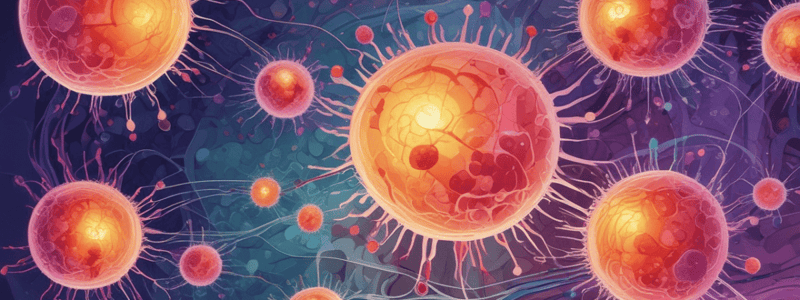Podcast
Questions and Answers
What is the primary function of the humoral immune response?
What is the primary function of the humoral immune response?
- Production of T cells
- Phagocytosis of pathogens
- Activation of cytotoxic T cells
- Production of immunoglobulins or antibodies (correct)
Where are antibodies mainly present in the body during an immune response?
Where are antibodies mainly present in the body during an immune response?
- Intracellular spaces
- Extracellular fluids (correct)
- Cytosol
- Mitochondria
Which of the following is NOT a class of antibodies?
Which of the following is NOT a class of antibodies?
- IgM
- IgX (correct)
- IgD
- IgE
What does somatic hypermutation refer to in the context of B cell biology?
What does somatic hypermutation refer to in the context of B cell biology?
Which cell type is responsible for somatic hypermutation?
Which cell type is responsible for somatic hypermutation?
What is the main outcome of affinity maturation in B cells?
What is the main outcome of affinity maturation in B cells?
Which signaling molecules downstream of the BCR pathway lead to B cell activation?
Which signaling molecules downstream of the BCR pathway lead to B cell activation?
What is the role of follicular dendritic cells in B cell activation?
What is the role of follicular dendritic cells in B cell activation?
What type of B cell is found in the follicles of the spleen and lymph nodes?
What type of B cell is found in the follicles of the spleen and lymph nodes?
Which B cell type responds to non-protein antigens and rapidly produces IgM?
Which B cell type responds to non-protein antigens and rapidly produces IgM?
What is the outcome of B cell signaling for each B cell?
What is the outcome of B cell signaling for each B cell?
Where do activated B cells and TFH cells migrate to for primary focus of B cell clonal expansion?
Where do activated B cells and TFH cells migrate to for primary focus of B cell clonal expansion?
What type of B cells are known as centroblasts during rapid proliferation?
What type of B cells are known as centroblasts during rapid proliferation?
Which cytokines sustain proliferation of centroblasts in the germinal center?
Which cytokines sustain proliferation of centroblasts in the germinal center?
Where do some of the B lymphoblasts attached to TFH cells traffick back to for rapid proliferation?
Where do some of the B lymphoblasts attached to TFH cells traffick back to for rapid proliferation?
What is the primary mechanism responsible for the high rate of mutations in B cells during affinity maturation?
What is the primary mechanism responsible for the high rate of mutations in B cells during affinity maturation?
Which cells in the germinal center express a B cell receptor (BCR or sIg+) after completing somatic hypermutation?
Which cells in the germinal center express a B cell receptor (BCR or sIg+) after completing somatic hypermutation?
In affinity maturation, which type of cells test the BCRs for affinity to antigens?
In affinity maturation, which type of cells test the BCRs for affinity to antigens?
What is the main outcome of the interaction between centrocytes with high affinity BCRs and follicular dendritic cells (FDC)?
What is the main outcome of the interaction between centrocytes with high affinity BCRs and follicular dendritic cells (FDC)?
Which molecule is captured by Fc receptors on FDC during the process of affinity maturation?
Which molecule is captured by Fc receptors on FDC during the process of affinity maturation?
What is the role of CD21 on centrocytes during interaction with antigens captured by FDC?
What is the role of CD21 on centrocytes during interaction with antigens captured by FDC?
Which signaling mechanisms are essential for the survival of centrocytes during affinity maturation?
Which signaling mechanisms are essential for the survival of centrocytes during affinity maturation?
What is the final outcome for centrocytes with the highest affinity BCR for antigens?
What is the final outcome for centrocytes with the highest affinity BCR for antigens?
What is the fate of centrocytes if they fail to interact with TFH cells and FDC?
What is the fate of centrocytes if they fail to interact with TFH cells and FDC?
What signaling molecules promote the proliferation and differentiation of GC B cells into plasma cells?
What signaling molecules promote the proliferation and differentiation of GC B cells into plasma cells?
Where do long-lived plasma cells primarily reside in the body?
Where do long-lived plasma cells primarily reside in the body?
What is the main role of memory plasma cells?
What is the main role of memory plasma cells?
Where do short-lived plasma cells primarily originate?
Where do short-lived plasma cells primarily originate?
Which cells differentiate into long-lived plasma cells in the bone marrow?
Which cells differentiate into long-lived plasma cells in the bone marrow?
What signaling molecules are associated with the BCR on B cells?
What signaling molecules are associated with the BCR on B cells?
Which kinase phosphorylates the immunoreceptor tyrosine-based activation motif (ITAM) on B cell receptors?
Which kinase phosphorylates the immunoreceptor tyrosine-based activation motif (ITAM) on B cell receptors?
What is the role of Syk in B cell activation signaling?
What is the role of Syk in B cell activation signaling?
Which component is NOT part of the B cell co-receptor?
Which component is NOT part of the B cell co-receptor?
What is the function of CD19 in B cell activation?
What is the function of CD19 in B cell activation?
Which process results in an increase in BCR signaling events up to 10,000-fold?
Which process results in an increase in BCR signaling events up to 10,000-fold?
Patients lacking functional CD19 or CD81 components have low levels of serum antibodies due to:
Patients lacking functional CD19 or CD81 components have low levels of serum antibodies due to:
'Centrocytes' in germinal centers are characterized by:
'Centrocytes' in germinal centers are characterized by:
Flashcards are hidden until you start studying
Study Notes
B Cell Activation and Differentiation
Humoral Immune Response
- Produces immunoglobulins (antibodies) to combat pathogens
- Antibodies present in blood, lymph, and extracellular fluids
- Five classes of antibodies: IgM, IgD, IgA, IgE, and IgG, each with different functions
Types of B Cell Responses
- Follicular B cells: produce all types of antibodies, require T cell help, and are found in spleen and lymph node follicles
- Marginal zone (MZ) B cells: respond to non-protein antigens, rapidly produce IgM, and are localized to the marginal zone
- B-1 B cells: respond to non-protein antigens, rapidly produce IgM, and are found in fetal liver and adult bone marrow
B Cell Activation
- Requires three signals: BCR signaling, B cell co-receptor signaling, and cytokine signaling
- BCR signaling: crosslinking of BCR by antigen epitopes, leads to phosphorylation of ITAMs and activation of Syk and downstream signaling pathways
- B cell co-receptor signaling: CD19, CD81, and CR2 recognize and bind to antigen-bound IgG and C3d, enhancing BCR signaling
- Cytokine signaling: CD40-CD40L interactions and cytokines from T cells (IL-2, IL-4, IL-5) promote B cell activation and proliferation
Germinal Center Formation
- Activated B cells and TFH cells migrate to the medulla and undergo clonal expansion
- B cells differentiate into centroblasts, which undergo rapid proliferation and somatic hypermutation
- Centrocytes are generated, which express a BCR and undergo affinity maturation
- Centrocytes with high affinity BCR for antigen survive and differentiate into plasma cells
Plasma Cells
- Short-lived plasma cells: produce IgM, are formed in the medulla, and undergo apoptosis
- Long-lived plasma cells: produce IgG, are localized to inflamed tissues and bone marrow, and constantly secrete low levels of Ig
Memory B Cells
- Remain in blood circulation or reside transiently in lymphoid organs
- Do not produce Ig, but express a BCR
- Serve as a reservoir for memory B cell responses
Memory B Cell Development
- FDC capture, concentrate, and slowly release antigens
- BCR signaling induces movement of BCR to the site of antigen contact, promoting BCR crosslinking and activation
Signaling Molecules
- Igα and Igβ contain cytoplasmic tails with ITAMs
- Syk binds to the ITAMs and acts similar to ZAP-70 in T cells
- PLC and Ras/Rac pathways are activated, leading to transcription factor binding and activation signals
Studying That Suits You
Use AI to generate personalized quizzes and flashcards to suit your learning preferences.




